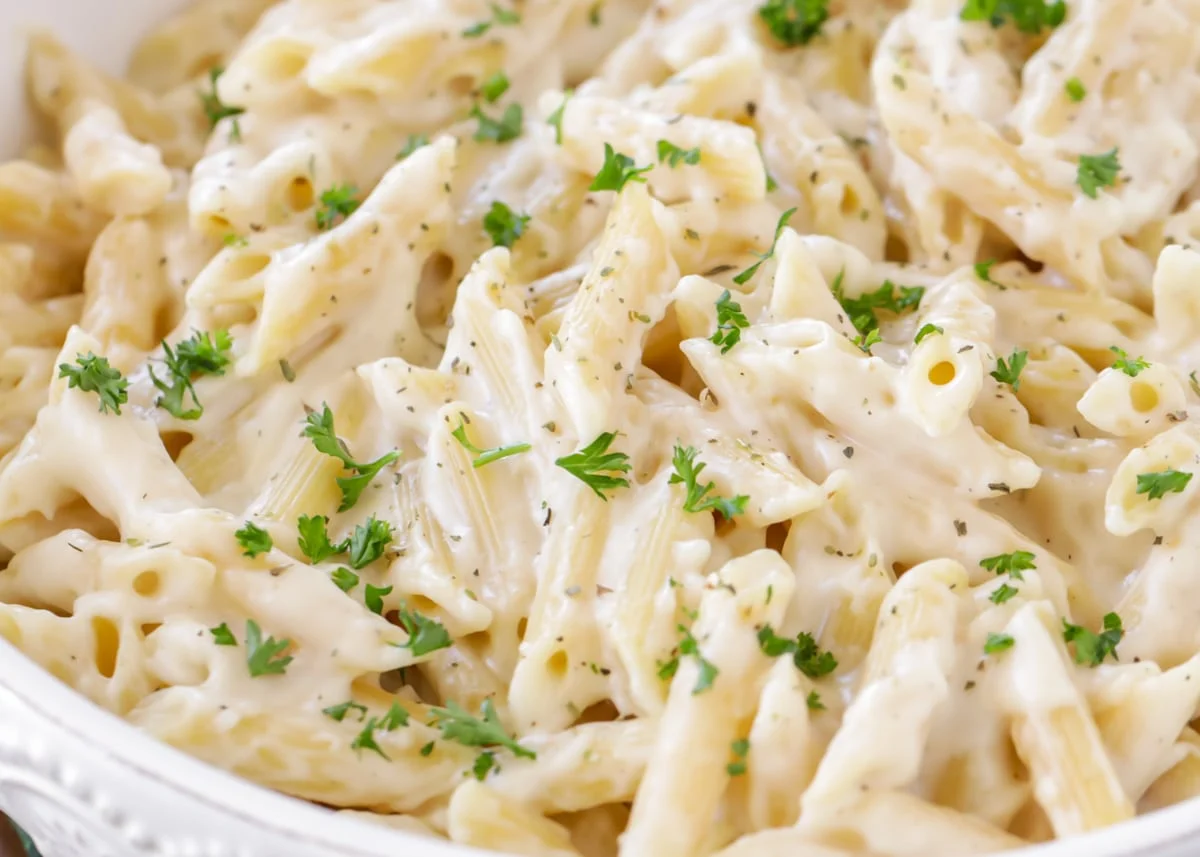White sauce penne pasta, known for its creamy texture and comforting flavors, is a beloved dish that combines al dente penne pasta with a rich, velvety white sauce. Originating from Italian culinary traditions, this dish has become popular worldwide for its simplicity and versatility. In this comprehensive guide, we will delve deeper into the origins of white sauce penne pasta, explore its ingredients, provide a detailed step-by-step recipe, suggest a variety of delicious variations, discuss its nutritional aspects, and offer tips for serving and enjoying this classic dish.
Origins and Cultural Significance

Penne pasta, characterized by its cylindrical shape and ridged texture, traces its roots to Italy, where it has been a staple in Italian cuisine for centuries. The name “penne” derives from the Italian word for quill, reflecting its shape resembling a quill or feather. Pasta dishes with creamy sauces, including white sauce, have long been favored in Italian cooking for their ability to create hearty and satisfying meals.
The béchamel sauce, or white sauce, used in this dish has French origins and is considered one of the fundamental sauces in classic French cuisine. It consists of a roux (butter and flour cooked together) combined with milk, resulting in a smooth and creamy base that can be enhanced with various ingredients like cheese, herbs, and spices.
Ingredients for White Sauce Penne Pasta
To prepare a delicious batch of white sauce penne pasta, gather the following ingredients:
- Penne Pasta: 1 pound (about 450 grams), cooked al dente according to package instructions.
- Butter: 4 tablespoons (1/2 stick).
- All-Purpose Flour: 4 tablespoons.
- Milk: 3 cups, preferably whole milk for a richer sauce.
- Salt: 1 teaspoon, or to taste.
- Black Pepper: 1/2 teaspoon, freshly ground.
- Nutmeg: 1/4 teaspoon, freshly grated (optional, for added flavor).
- Parmesan Cheese: 1 cup, grated (plus extra for serving).
- Fresh Parsley: 2 tablespoons, finely chopped (for garnish).
Step-by-Step Recipe for White Sauce Penne Pasta
Step 1: Cook the Penne Pasta
- Boil Water: Bring a large pot of salted water to a boil.
- Cook Pasta: Add the penne pasta and cook according to the package instructions until al dente.
- Drain and Reserve: Drain the pasta, reserving about 1/2 cup of pasta cooking water. Set aside.
Step 2: Prepare the White Sauce
- Melt Butter: In a large skillet or saucepan, melt the butter over medium heat.
- Make Roux: Once melted, add the all-purpose flour and whisk continuously to form a smooth paste (roux). Cook for 1-2 minutes, stirring constantly, until the raw flour smell dissipates.
- Add Milk: Gradually pour in the milk, whisking constantly to prevent lumps from forming.
- Thicken Sauce: Cook the sauce over medium heat, stirring frequently, until it thickens enough to coat the back of a spoon, about 8-10 minutes.
- Season: Season the sauce with salt, black pepper, and nutmeg, adjusting to taste.
Step 3: Combine Pasta and Sauce
- Mix Together: Add the cooked penne pasta to the skillet with the white sauce.
- Coat Pasta: Toss gently to coat the pasta evenly with the sauce. If needed, add some of the reserved pasta cooking water to loosen the sauce.
- Add Cheese: Stir in the grated Parmesan cheese, reserving some for garnish.
Step 4: Serve
- Plate Pasta: Transfer the white sauce penne pasta to serving plates or bowls.
- Garnish: Sprinkle with additional grated Parmesan cheese and chopped fresh parsley.
- Enjoy: Serve hot, accompanied by garlic bread or a crisp green salad.
Variations of White Sauce Penne Pasta
White sauce penne pasta offers endless possibilities for customization:
- Chicken Alfredo Penne: Incorporate grilled or sautéed chicken breast strips for added protein and flavor.
- Vegetarian Delight: Add sautéed vegetables such as mushrooms, spinach, or bell peppers to the sauce for a vegetarian option.
- Seafood Medley: Mix in cooked shrimp, scallops, or crab meat to create a seafood-inspired dish.
- Sun-Dried Tomato and Basil: Stir in chopped sun-dried tomatoes and fresh basil leaves for a Mediterranean twist.
- Spicy Arrabbiata: Infuse the sauce with crushed red pepper flakes or a dash of hot sauce for a spicy kick.
Nutritional Benefits of White Sauce Penne Pasta

While white sauce penne pasta is indulgent, it can still be part of a balanced diet when enjoyed in moderation:
- Protein: Adding chicken or seafood increases the protein content, essential for muscle repair and overall health.
- Calcium: Parmesan cheese provides calcium, important for bone health.
- Complex Carbohydrates: Pasta offers complex carbohydrates for sustained energy.
- Moderation: Control portion sizes and balance with nutritious side dishes like vegetables or a salad.
Tips for Cooking and Serving
To enhance your white sauce penne pasta experience:
- Cook Pasta Al Dente: Ensure the pasta is cooked al dente (firm to the bite) to maintain texture.
- Use Quality Ingredients: Opt for fresh Parmesan cheese and whole milk for a richer flavor.
- Garnish Creatively: Experiment with garnishes like fresh herbs, additional cheese, or a drizzle of olive oil.
- Pairing: Serve with garlic bread, breadsticks, or a side of vegetables for a well-rounded meal.
- Storage: Store leftovers in an airtight container in the refrigerator for up to 3 days, reheating gently on the stove or in the microwave.
Conclusion
White sauce penne pasta epitomizes comfort and satisfaction, making it a favorite among pasta enthusiasts worldwide. Whether enjoyed for a cozy dinner at home or served at a special gathering, this dish offers creamy indulgence with every bite. By following the recipe, exploring different variations, and considering nutritional aspects, you can create a personalized white sauce penne pasta that delights the senses and satisfies the palate. Embrace the simplicity and versatility of this classic dish—it’s sure to become a staple in your culinary repertoire.
Read Also: Crispy Delight: The Art of Fried Zucchini
